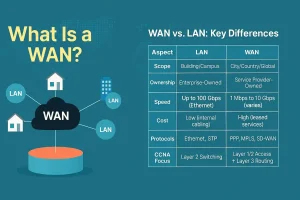Introduction to WAN Technologies
Wide-area networks (WANs) are used to connect different LANs together. They can bridge LANs within a city, country, or global region. For CCNA candidates, understanding WANs is crucial for the 200-301 exam’s Network Fundamentals domain (15-25% weightage). CCNP students dive deeper into scalable WAN designs via ENCOR (20-30% on WAN optimization). Here’s why WANs matter: […]

